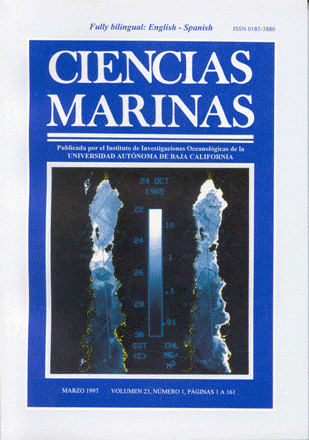On the structure of a deep scattering layer on the coastal shelf off bahía magdalena, baja california, mexico
Contenido principal del artículo
Resumen
Se describe la composición específica y estructura de una capa de dispersión profunda encontrada en el suroeste de la península de Baja California, México. Los muestreos se realizaron mediante arrastres con red Isaacs-Kidd, red Bongo y registros hidroacústicos. Los resultados demuestran la dominancia de tres especies: un eufáusido, Euphausia eximia Hansen 1911; un decápodo de la familia Galatheidae. Pleuroncodes planipes (Stimpson. 1860); y un pez de la familia Photichthyidae, Vinciguerria lucetia (Garman, 1899). Los ecos acústicos de la capa de dispersión profunda fueron separados de acuerdo con la fuerza de blanco usando una ecosonda SIMRAD EY-200, con una frecucncia de 200 kHz. y un programa denominado Hydro Acoustic Data Acquisition System (HADAS). Los eufáudidos fueron asociados con un intervalo de fuerza de blancos entre -56 y -62 dB, las langostillas entre -51 y -55 dB,.y los peces entre -32 y -50 dB. Los resultados indican que los organismos presentaron una distribución no azarosa dentro de Ia capa de dispersión profunda, esto es,.tuvieron una estructura interna tanto en sentido horizontal como vertical.
The structure of an intense deep scattering layer off the southwest coast of Baja California, Mexico, is described using Isaacs-Kidd net trawl samples, Bongo samples and hydroacoustic records. Results demonstrate the dominance of three organisms: an euphausiid, Euphausia eximia Hansen 1911; a decapad of the family Galatheidae, Pleuroncodes planipes (Stimpson, 1860); and a fish of the family Photichthyidae, Vinciguerria lucetia (Garman, 1899). Using a SIMRAD EY-200 echosounder, with a working frequency of 200 kHz, and a Hydro Acoustic Data Acquisition System (HADAS), echoes were separated according to their target strength. Euphausiids were associated with the -56 to -62 dB target strength group, the red crabs with the -51 to -55 dB group, and fishes with the -32 to -50 dB group. Results indicate that organisms within the layer were not randomly distributed, but that they have an internal] structure both in a horizontal and vertical dimension.
The structure of an intense deep scattering layer off the southwest coast of Baja California, Mexico, is described using Isaacs-Kidd net trawl samples, Bongo samples and hydroacoustic records. Results demonstrate the dominance of three organisms: an euphausiid, Euphausia eximia Hansen 1911; a decapad of the family Galatheidae, Pleuroncodes planipes (Stimpson, 1860); and a fish of the family Photichthyidae, Vinciguerria lucetia (Garman, 1899). Using a SIMRAD EY-200 echosounder, with a working frequency of 200 kHz, and a Hydro Acoustic Data Acquisition System (HADAS), echoes were separated according to their target strength. Euphausiids were associated with the -56 to -62 dB target strength group, the red crabs with the -51 to -55 dB group, and fishes with the -32 to -50 dB group. Results indicate that organisms within the layer were not randomly distributed, but that they have an internal] structure both in a horizontal and vertical dimension.
Descargas
Los datos de descargas todavía no están disponibles.
Detalles del artículo
Cómo citar
Robinson, C., Gómez, J., & Arenas, V. (1997). On the structure of a deep scattering layer on the coastal shelf off bahía magdalena, baja california, mexico. Ciencias Marinas, 23(1), 141–154. https://doi.org/10.7773/cm.v23i1.769
Número
Sección
Artículo de investigación
Este es un artículo de acceso abierto distribuido bajo una licencia Creative Commons Attribution 4.0, que le permite compartir y adaptar el trabajo, siempre que dé el crédito apropiado al autor o autores originales y la fuente, proporcione un enlace a Creative Commons licencia, e indicar si se realizaron cambios. Las figuras, tablas y otros elementos del artículo están incluidos en la licencia CC BY 4.0 del artículo, a menos que se indique lo contrario. El título de la revista está protegido por derechos de autor y no está sujeto a esta licencia. La escritura de licencia completa se puede ver aquí.

